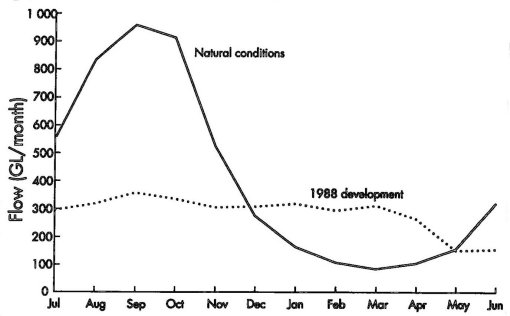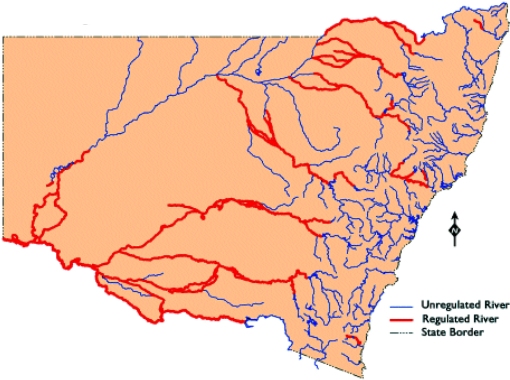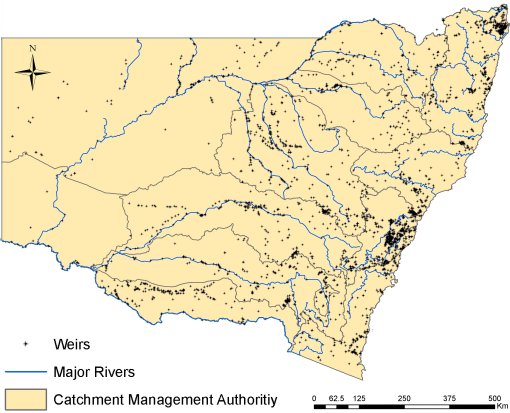
Water flow
The rivers of NSW have naturally irregular flow regimes with long periods of drought punctuated with substantial floods. Native flora and fauna have adapted to natural flows over thousands of years. Periods of low and high flow support a rich diversity of organisms and habitats and have an important ecological function.
The greatest threat to native fish has been the construction of large dams and weirs on rivers to regulate their flow for access as urban and rural water supplies. This is known as the “regulation” of rivers.
Structures that modify water flow
Alteration to natural flow regimes can occur by:
- reducing or increasing flows
- altering the seasonality of flows
- changing the frequency, duration, magnitude, timing, predicability and variability of flow events
- altering surface and subsurface water levels
- changing the rate of rise or fall of water levels.
Instream structures that modify natural flow include dams, weirs, canals, navigation locks, floodgates, road crossings, flow regulators, levee banks and erosion control structures.
The installation and operation of these structures that alter natural water flow have been identified as a Key Threatening Process under the Fisheries Management Act 1994.
These structures have been installed and operated for a number of reasons:
- locks allow navigation on large rivers to facilitate boating traffic. In the past, this included commercial freight transport
- weirs create pool environments for diversion into irrigation channels, for pump intakes, recreational boating and swimming, and other aesthetic reasons
- dams store water for stock, domestic and irrigation supply, and for flood mitigation
- floodgates and levee banks control floodwaters on urban and agricultural land and prevent upstream saltwater intrusions in coastal areas
- road crossings allow traffic to pass over waterways.
Water flow can also be affected by structures not in the waterway itself. Most catchments have been cleared extensively for urban and / or rural development. During major rainfall or flood events this means there are increased volumes and velocities of water entering the waterways. In more urbanised areas, the increase of the land surface under hard surfaces can cause changes to natural flow patterns. For example, more water runs off faster from a car park than a playing field and less still runs off from a forest. Vegetation serves to slow the flow of water and increase its infiltration into soil and groundwater storages. This enables the water to flow more gradually into watercourses over a longer period of time. Without the vegetation, increased flow generally results in erosion and scouring of receiving watercourses.
The impact of regulation on native fish
- Disruption to natural environmental cues necessary for reproductive cycles.
Some native fish rely on high flows during winter and spring as cues to begin migration and spawning. Without these seasonal high flows, breeding can be severely affected. For example, Murray cod migrate upstream on high flows in early spring then return downstream when river levels drop in the summer. Female tupong (congolli) migrate downstream to spawn in marine or estuarine spawning grounds only when there are high flows in the late autumn or winter.
- Impaired spawning, growth, recruitment, feeding and other life cycle processes of native fish resulting from the release of cold water from low level dam outlets.
- Creation of physical barriers to native fish movement and migration.
- Reduction of available habitat due to:
- changes in the area, frequency and duration of floodplain and wetland inundation
- alteration to the natural processes of sediment erosion, transport and deposition
- Extraction and dredging activities can destroy instream habitats, change natural flows and decrease water clarity.
- Altering instream physical, chemical and biological conditions can change the biota, resulting in less food being available for fish.
The constant presence of water, rather than periodic floods and droughts, favours the habitat needs of introduced fish. This means that species such as carp can infest our rivers and creeks much more easily. In rivers without dams, such as the Paroo River, there are relatively few carp, and native fish dominate more than they do in rivers with dams.
Weir pool environments also provide ideal conditions for harmful algal blooms.
Drought is a natural feature of our landscape and results in exceptionally low summer flows. Under natural conditions, these events can result in large reductions in fish populations, however, native fish species are adapted to drought and populations have the capacity to recover once the drought breaks. When water regulation and/or extraction causes drought-like conditions every year, there is little chance for fish to recolonise areas and for populations to recover.
Other impacts of regulation
Regulated flow
Dams and weirs are constructed on waterways to trap water during high natural flows, reducing or even eliminating the occurence of flooding downstream. Water is then released during summer for irrigation and other water supply needs. The timing of these releases is often out of phase with the natural regime (Figure 1).

Figure 1. Modelled median monthly flow volumes (GL)downstream of Yarrawonga weir on the Murray River under natural and 1988 development conditions, indicating the reductions in flow volumes due to irrigation diversions. (Adapted from: “Rivers as Ecological Systems: The Murray-Darling Basin’)
This change in natural flow, known as 'seasonal flow reversal', has ecological impacts such as drowning of riparian vegetation and wetlands which are adapted to temporary inundation.
Releases can also cause abnormally rapid changes in the volume and speed of water in a river system. Sudden rises and falls in river levels resulting from water release and subsequent extraction for irrigation can have an effect on bank stability, causing slumping, loss of riparian vegetation, erosion and sedimentation.
Flood regimes
Water storage areas trap medium flows, or 'freshes', that move through the river system from the upper catchments. This has dramatically reduced the frequency of small floods, which are particularly important for billabongs and other wetlands. Lowland river food webs depend on the input of organic matter provided by the small freshes and the associated inundation of wetlands.
In the Murray-Darling River system, rises in water level accompanied by rises in temperature provide important cues for spawning of some fish. For example, golden perch often spawn following a rise in river height when the temperature is approximately 23oC. If river rises do not occur, spawning is delayed until the following season.
River regulation in NSW
Figure 2 illustrates the regulated rivers of NSW. In addition, there are approximately 4000 licensed weirs and barriers on waterways in NSW (see Figure 3).

Figure 2. NSW Regulated rivers

Figure 3. Weirs throughout NSW

